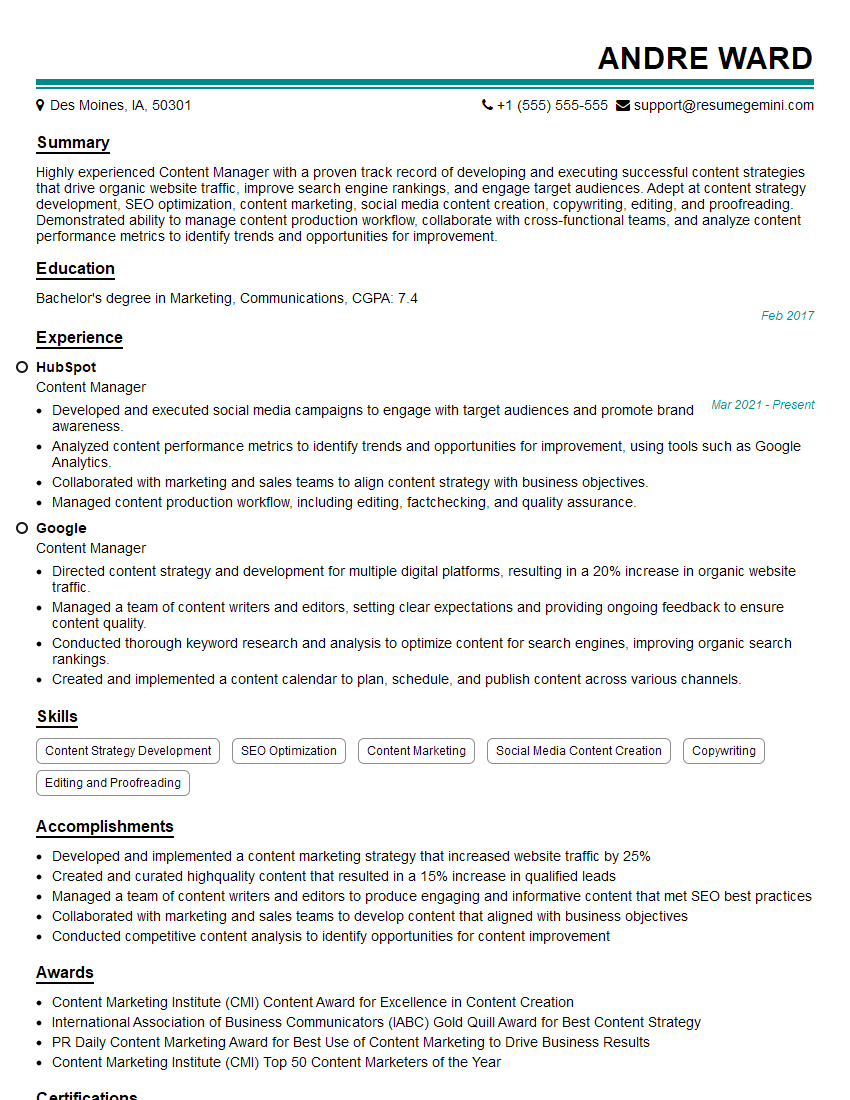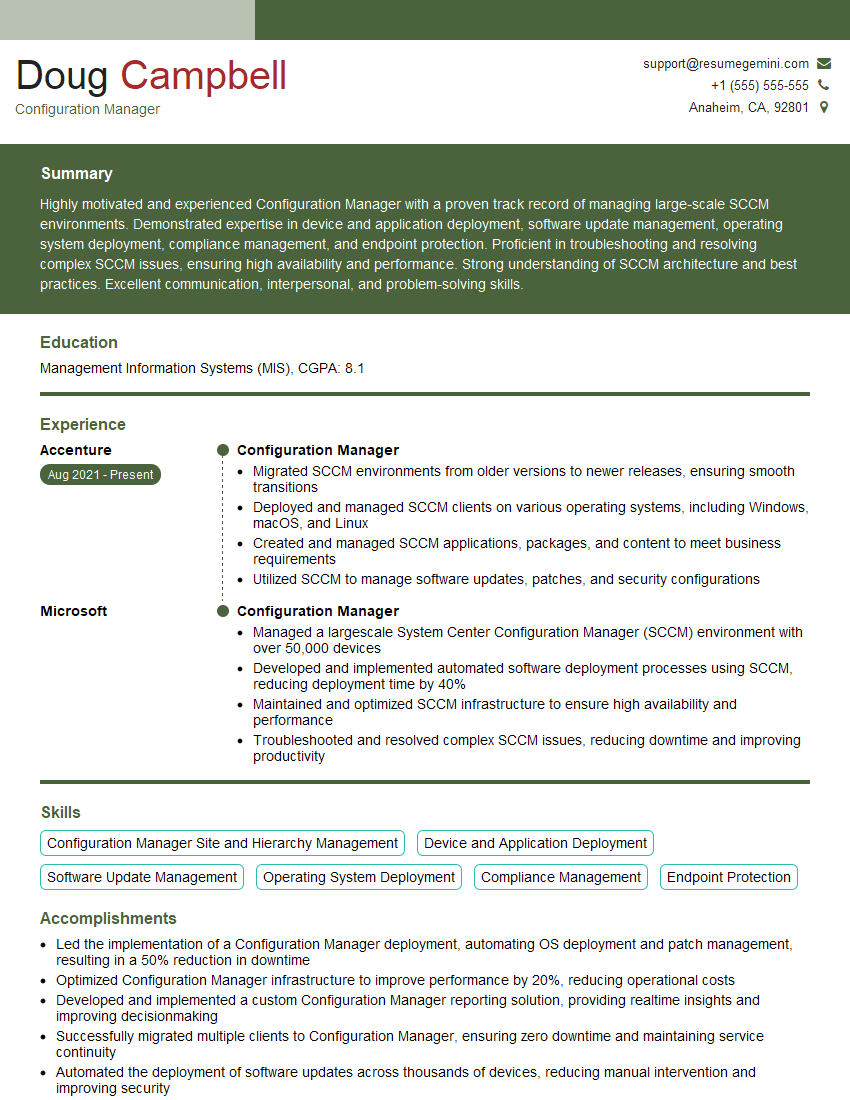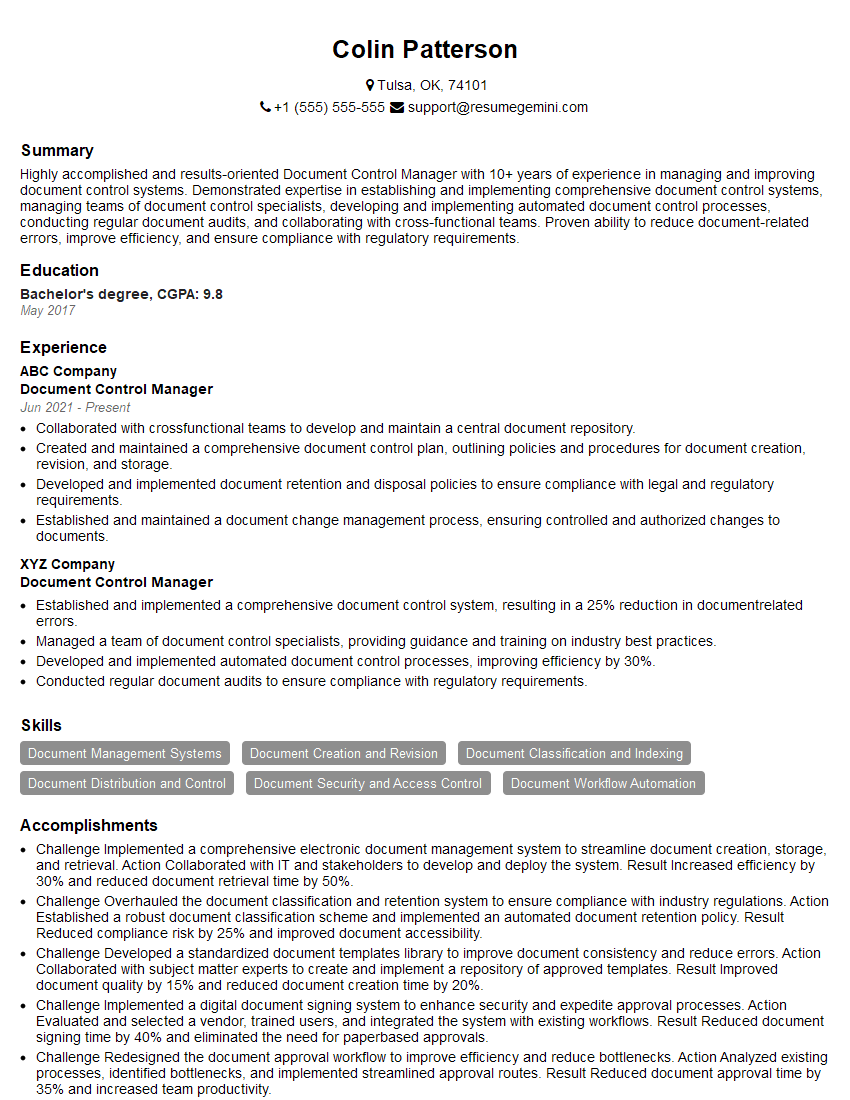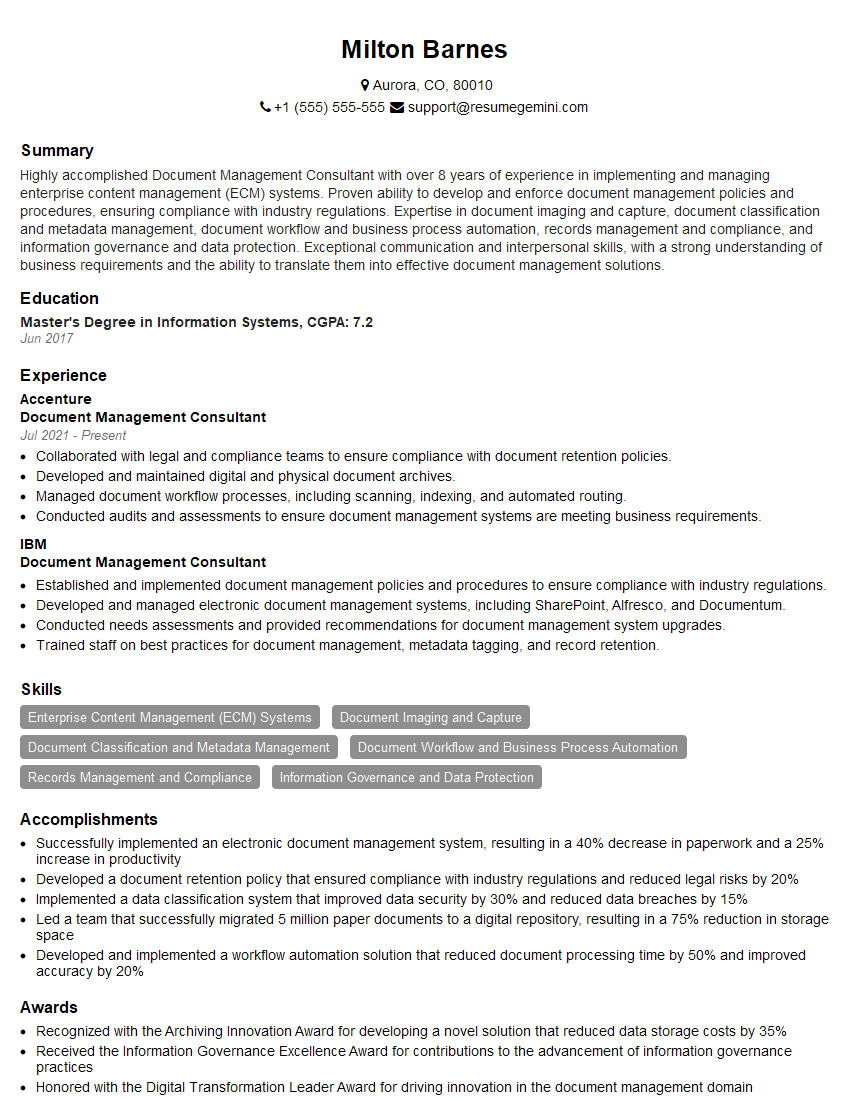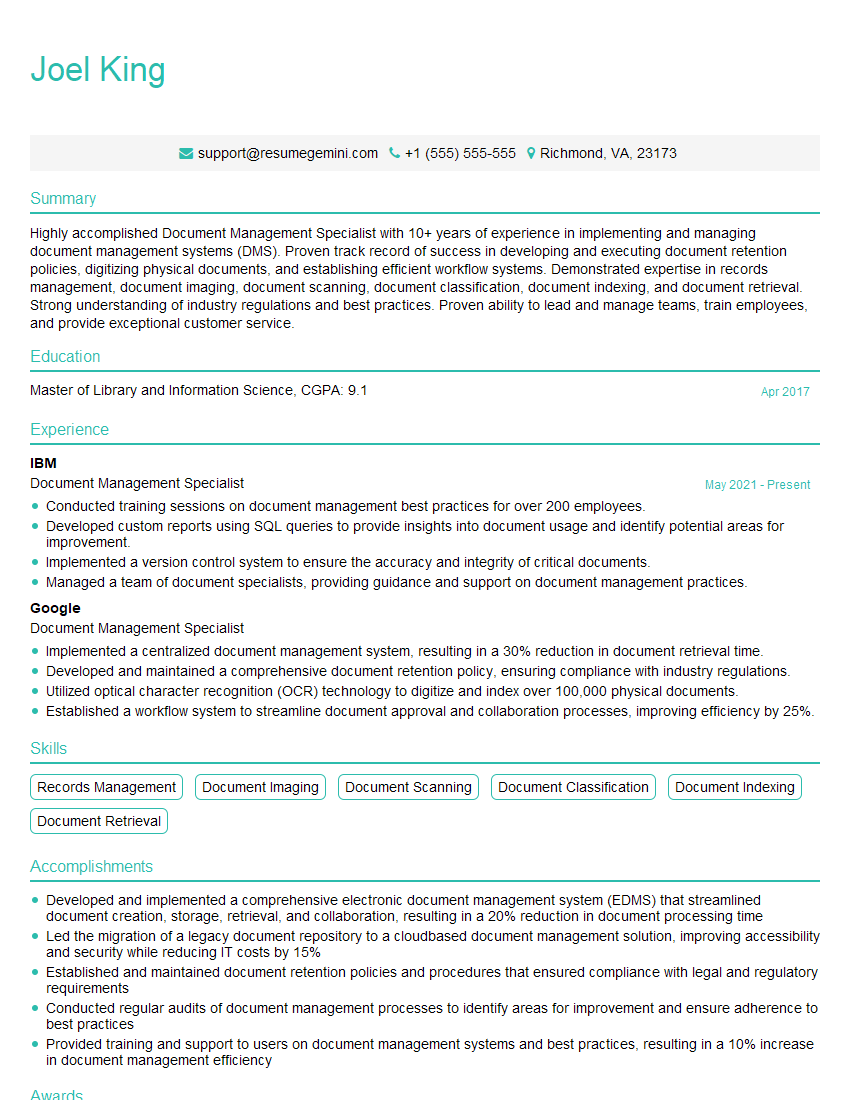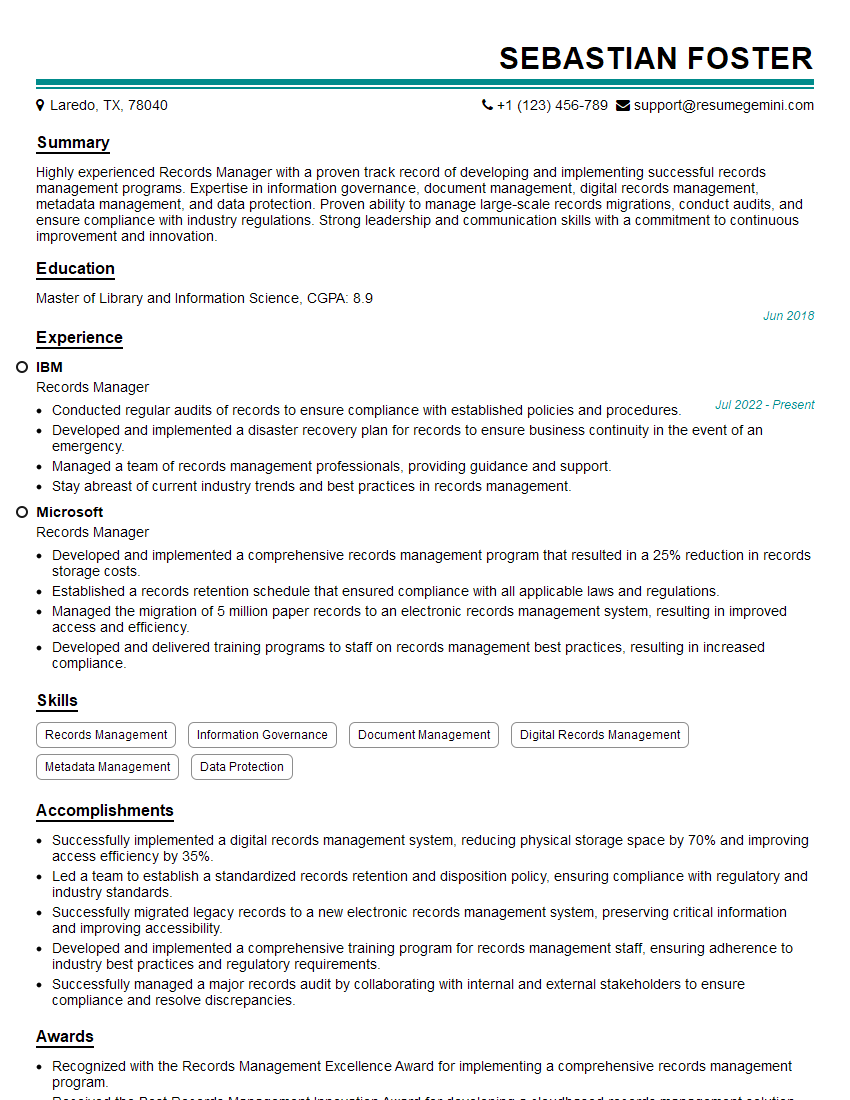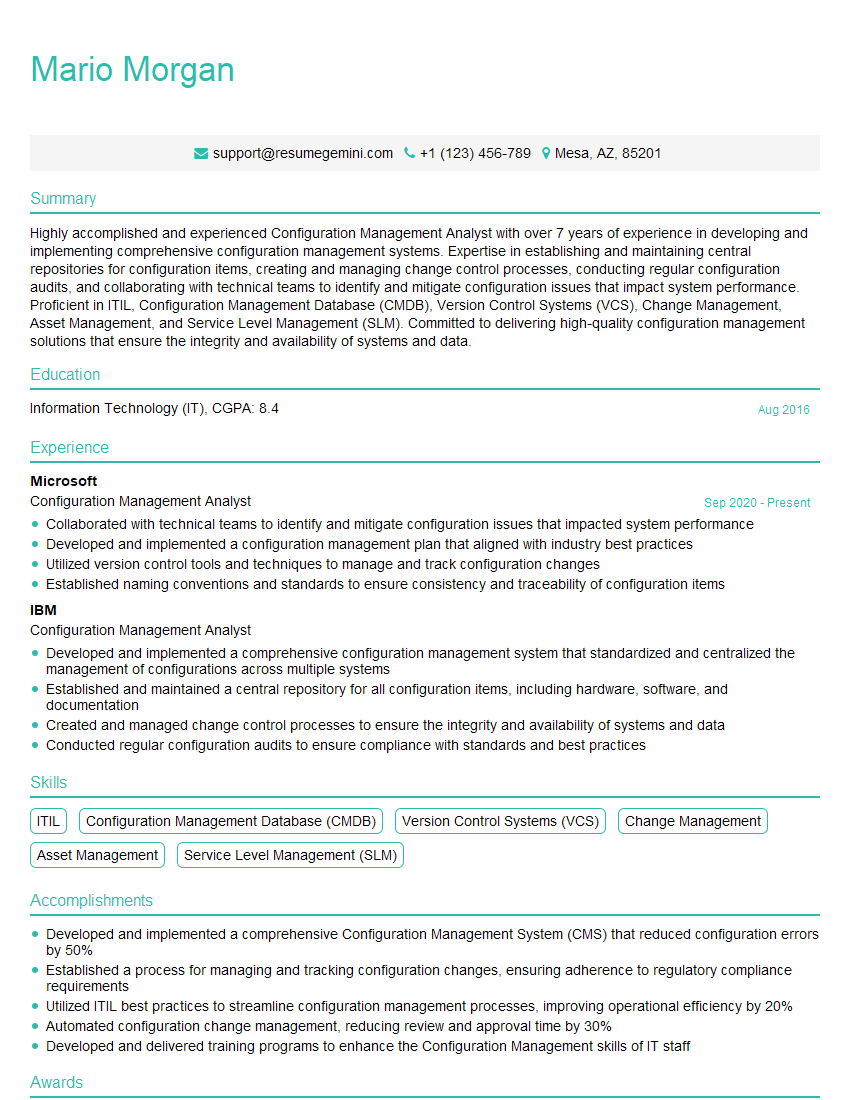The right preparation can turn an interview into an opportunity to showcase your expertise. This guide to Document Management Configuration Management interview questions is your ultimate resource, providing key insights and tips to help you ace your responses and stand out as a top candidate.
Questions Asked in Document Management Configuration Management Interview
Q 1. Explain the difference between Document Management and Configuration Management.
While both Document Management and Configuration Management deal with managing information, their focuses differ significantly. Think of it like this: Document Management is about organizing and controlling all documents within an organization, regardless of their role in a specific product or system. Configuration Management, on the other hand, is specifically focused on managing the baseline documents and artifacts that define a system’s structure and function. It tracks changes to these critical items throughout the system’s lifecycle.
Document Management encompasses everything from contracts and employee records to project plans and marketing materials. It prioritizes accessibility, version control, and security. Configuration Management, conversely, focuses on the precise definition and control of a system’s components. It emphasizes traceability, change control, and ensuring the system consistently meets its requirements. A change to a configuration item (like a software module) might be documented and tracked through Configuration Management, while the related design document would fall under Document Management.
Q 2. Describe your experience with version control systems in document management.
I have extensive experience with various version control systems (VCS) in document management, including Git, SVN, and SharePoint’s built-in versioning. My experience goes beyond simply using these systems; I’ve configured and optimized them to meet specific organizational needs. For instance, in a previous role, we migrated from a file-sharing system to Git for technical documentation. This involved training the team, establishing branching strategies (like Gitflow), and integrating the VCS with our existing document management system. The result was improved collaboration, easier version tracking, and a significant reduction in document conflicts.
In another project, I worked with SharePoint’s versioning capabilities to manage legal contracts. We configured the system to enforce mandatory approval workflows before publishing new contract versions, thereby improving the audit trail and regulatory compliance. The key here is understanding how the specific features of a VCS can be tailored to fit the unique needs of document management within a given context.
Q 3. How do you ensure document integrity and prevent unauthorized modifications?
Ensuring document integrity and preventing unauthorized modifications relies on a multi-layered approach. This starts with access control, where permissions are carefully assigned based on the principle of least privilege. Only authorized personnel should have editing rights. We also utilize robust version control systems, allowing us to track changes, revert to previous versions, and identify who made what modifications. Digital signatures and checksum verification can further enhance integrity by proving authenticity and detecting tampering. For sensitive documents, encryption both at rest and in transit adds another layer of security.
Regular audits and system monitoring are crucial for identifying and addressing potential vulnerabilities. Finally, a well-defined document management policy, clearly outlining the procedures for handling documents, is the cornerstone of a secure system. Imagine a library with a strict check-in/check-out system, security cameras, and a catalog – that’s the principle behind securing a document management system.
Q 4. What are the key elements of a robust document management system?
A robust document management system (DMS) needs several key elements to be truly effective. These include:
- Centralized Repository: A single, easily accessible location for all documents.
- Version Control: A mechanism for tracking changes and reverting to previous versions.
- Metadata Management: The ability to tag documents with descriptive information for easy searching and retrieval.
- Access Control and Security: Permissions to limit access based on roles and responsibilities.
- Workflow and Approval Processes: Automated workflows to manage document creation, review, and approval.
- Search and Retrieval Capabilities: Powerful search functionality to locate documents quickly and easily.
- Integration with other systems: Seamless integration with other business applications such as CRM or ERP systems.
- Audit Trails: Complete records of all document activity for compliance and accountability.
Without these elements, a DMS risks becoming disorganized, insecure, and ultimately ineffective.
Q 5. Explain your experience with metadata and its role in effective document management.
Metadata is the backbone of effective document management. It’s the descriptive information that we associate with documents, going beyond the document’s name or content. Imagine metadata as the index cards in a library catalog: they provide the key information needed to find specific books. In a DMS, metadata might include author, creation date, keywords, project name, and classification codes. Effective metadata management enables powerful search capabilities, making it easier to find relevant documents quickly.
My experience includes designing and implementing metadata schemas for various types of documents. For instance, I developed a metadata schema for engineering drawings that included revision number, drawing scale, and material specifications. This allowed engineers to easily locate and filter specific drawings, improving their efficiency. Furthermore, I’ve leveraged metadata to automate document routing within approval workflows, significantly streamlining the document review process.
Q 6. Describe a time you had to troubleshoot a document management system issue.
In a previous role, we experienced performance issues with our DMS. Documents took an excessively long time to load, and searches returned slow results. My troubleshooting involved a systematic approach:
- Initial Assessment: I began by gathering performance metrics (load times, search response times) and user feedback.
- Identifying the Bottleneck: Using system logs and monitoring tools, I pinpointed the bottleneck to the database server. It appeared to be struggling to handle the increasing volume of documents and metadata.
- Solution Implementation: We implemented a database optimization strategy that included indexing crucial metadata fields, upgrading server hardware, and tuning database queries. We also investigated and implemented database partitioning to distribute the load more effectively.
- Validation: After implementing the solution, we retested the system and verified that performance had returned to acceptable levels.
This experience highlighted the importance of proactive system monitoring, performance testing, and a well-defined escalation process for addressing critical issues.
Q 7. How do you handle conflicting document versions?
Handling conflicting document versions requires a clear and well-defined process. The first step is to identify the conflict, which usually involves comparing the differing versions to understand the nature of the changes. Then, we use the version control system to resolve the conflict. This often involves merging the changes manually, choosing one version to overwrite the other, or creating a new version that incorporates elements from both. The choice of resolution method depends on the context and the nature of the conflicting changes.
Communication is key during conflict resolution. Involving all relevant stakeholders and documenting the decision-making process ensures transparency and helps prevent future conflicts. A robust version history allows us to easily revert to previous versions if the chosen resolution isn’t satisfactory. Think of it as a collaborative editing process where we need to merge changes carefully to produce a cohesive final document.
Q 8. What are your preferred methods for document indexing and retrieval?
Effective document indexing and retrieval hinges on a well-defined metadata strategy and the right technology. My preferred methods involve a combination of controlled vocabularies, automated tagging, and robust search capabilities.
For controlled vocabularies, I utilize thesauri and ontologies to ensure consistency in how documents are categorized. This avoids the ambiguity of using free-text keywords. For example, instead of users tagging a document with various forms of ‘project report,’ we use a standardized term like ‘Project Progress Report’ from a pre-defined list. This ensures consistent searching and retrieval.
Automated tagging leverages natural language processing (NLP) and machine learning (ML) to automatically extract keywords and metadata from documents. This significantly reduces manual effort and improves efficiency. Think of it like having a smart assistant automatically categorize your emails based on their content.
Finally, a powerful search engine is essential, capable of handling both keyword searches and metadata-based filtering. I favor systems that offer features like fuzzy matching (allowing for slight variations in spelling), wildcards, and Boolean operators (AND, OR, NOT) to refine search results. This allows users to quickly locate even obscure documents.
Q 9. What strategies do you use to ensure document security and compliance?
Document security and compliance are paramount. My strategy is multifaceted, encompassing access controls, encryption, version control, and audit trails.
Access controls involve restricting document access based on user roles and permissions. For instance, only authorized personnel can access sensitive financial records. This often utilizes role-based access control (RBAC) systems, ensuring that individuals have only the permissions they need to perform their jobs.
Encryption protects documents both at rest (stored on servers) and in transit (during transfer). This prevents unauthorized access even if the documents are intercepted. We would utilize TLS/SSL encryption for data in transit and AES-256 encryption for data at rest.
Version control helps maintain the integrity of documents. It tracks all changes, enabling us to revert to earlier versions if necessary and providing a clear audit trail. A robust version control system allows for comparisons between different versions, collaboration, and easy rollback to previous states.
Finally, comprehensive audit trails meticulously record all actions performed on documents. These trails are crucial for compliance audits and investigations, providing detailed information about who accessed, modified, or deleted a document and when.
Q 10. Explain your experience with different document formats and their management.
My experience spans a broad range of document formats, including common office files (Word, Excel, PowerPoint, PDFs), images (JPEG, TIFF, PNG), CAD drawings (DWG, DXF), and specialized formats specific to various industries. Managing diverse formats requires a flexible approach.
For common office files, standard document management systems generally suffice. However, specialized formats may require dedicated software or conversion tools. For example, managing CAD drawings often involves integrating CAD software with the document management system, allowing for viewing, version control, and collaboration directly within the system.
The key is to utilize a system capable of either directly handling diverse formats or converting them into a common, searchable format. Optical character recognition (OCR) is essential for converting scanned documents and images into searchable text. Metadata tagging is then crucial to index these converted files for efficient retrieval.
Managing large files (such as CAD drawings or high-resolution images) might require dedicated storage solutions, such as cloud storage with optimized content delivery networks (CDNs), to ensure fast access and avoid performance bottlenecks.
Q 11. How do you ensure the accuracy and completeness of documents?
Ensuring document accuracy and completeness is a continuous process, involving rigorous quality control checks and workflows. This starts with establishing clear templates and guidelines for document creation.
For example, we may use templates with mandatory fields, ensuring that all critical information is captured. A standardized checklist can be integrated into the workflow to guide authors through the necessary steps, preventing omissions.
Multiple levels of review and approval are essential. Depending on the document’s sensitivity and importance, multiple stakeholders may need to review and approve before it is considered finalized. This includes peer reviews, subject-matter expert (SME) reviews and managerial sign-offs.
Finally, a robust version control system is indispensable for maintaining an accurate record of changes and allowing for easy rollback to previous versions if errors are discovered. Detailed audit trails further strengthen accountability and provide transparency.
Q 12. Describe your experience with workflow automation in document management.
Workflow automation is critical for streamlining document management processes. I’ve extensively used workflow automation tools to automate tasks such as routing documents for approval, notification of updates, and automatic indexing.
For instance, a new contract might automatically be routed to the legal department for review, then to finance for approval, and finally to sales for execution. The system can automatically send notifications at each stage, keeping everyone informed and ensuring timely progress. This reduces manual intervention, minimizes delays and human errors.
Automation also enhances efficiency in document indexing and metadata tagging by automatically extracting information from the documents themselves, reducing manual effort and improving consistency.
I’ve implemented workflows using platforms like SharePoint, Nintex Workflow Cloud and similar tools to design and implement automated processes. The choice of platform depends on the specific requirements of the organization and the level of customization needed.
Q 13. How do you manage document retention and disposal according to legal and regulatory requirements?
Document retention and disposal must strictly adhere to legal and regulatory requirements, which vary widely depending on industry, geography, and the type of document. My approach involves a carefully defined retention policy and a secure disposal mechanism.
The retention policy outlines how long different types of documents must be retained and specifies the storage method (physical or digital). This policy must be aligned with relevant laws and regulations like GDPR, HIPAA (if applicable), or industry-specific standards.
For example, financial records typically have longer retention periods than marketing materials. The policy should clearly differentiate these requirements and specify the actions to be taken once the retention period expires.
Secure disposal is vital for protecting sensitive information. Physical documents are typically shredded and recycled, while digital documents are permanently deleted and securely overwritten to prevent data recovery. We may utilize certified destruction services to ensure compliance with data privacy regulations.
Q 14. Explain your understanding of document lifecycle management.
Document lifecycle management (DLM) encompasses the entire journey of a document, from creation to final disposal. It involves a structured approach to managing documents throughout their various stages.
The lifecycle typically includes stages such as creation, review, approval, distribution, storage, archiving, and finally, disposal. Each stage has specific requirements and procedures to ensure efficiency, accuracy, and compliance.
Effective DLM requires a well-defined workflow, robust technology, and clear responsibilities. It’s not just about storing documents but managing them effectively across their entire lifecycle to minimize risks and maximize value. Proper DLM ensures that documents are readily accessible when needed, that versions are properly tracked, and that obsolete or sensitive documents are disposed of securely and in accordance with regulations.
Think of it like managing a product’s life cycle, but instead of a physical product, we are managing information. Understanding and managing each stage effectively ensures the smooth functioning of the entire system.
Q 15. How do you train users on proper document management procedures?
Training users on proper document management procedures is crucial for a system’s success. It’s not just about showing them how to use the software, but instilling a culture of proper document handling. My approach is multifaceted and includes:
- Initial Training: A comprehensive session covering the system’s functionality, including document upload, version control, metadata tagging, search techniques, and workflow processes. We use hands-on exercises and real-world examples relevant to their roles.
- Role-Based Training: Recognizing that different roles have varying needs, I tailor training to specific job functions. For instance, engineers need thorough training on revision control, while administrative staff focus on archiving and access permissions.
- On-the-Job Support: Providing ongoing support through dedicated help desks, FAQs, and quick reference guides. I also conduct regular check-ins to answer questions and address concerns.
- Reinforcement and Updates: Regular refresher courses and email updates keep users informed about system enhancements and best practices. This ensures everyone remains aligned with evolving procedures.
- Gamification (where appropriate): For larger teams, I’ve found that introducing elements of gamification, such as leaderboards for document completion rates or accuracy in metadata tagging, can significantly boost engagement and improve adoption.
For example, in a previous role, I implemented a tiered training system using a combination of online modules, in-person workshops, and personalized coaching, resulting in a 20% increase in user compliance with document management protocols within three months.
Career Expert Tips:
- Ace those interviews! Prepare effectively by reviewing the Top 50 Most Common Interview Questions on ResumeGemini.
- Navigate your job search with confidence! Explore a wide range of Career Tips on ResumeGemini. Learn about common challenges and recommendations to overcome them.
- Craft the perfect resume! Master the Art of Resume Writing with ResumeGemini’s guide. Showcase your unique qualifications and achievements effectively.
- Don’t miss out on holiday savings! Build your dream resume with ResumeGemini’s ATS optimized templates.
Q 16. How do you handle document change requests?
Handling document change requests requires a structured approach to ensure version control and maintain data integrity. My process involves:
- Request Submission: Users submit change requests through a designated channel, providing clear details about the necessary modifications and the rationale behind them.
- Review and Approval: A designated approver reviews the request, ensuring it aligns with organizational policies and standards. This often involves assessing the potential impact of the changes.
- Version Control: The change is implemented, creating a new version of the document. The system automatically tracks revisions, enabling easy access to previous versions if needed.
- Notification and Communication: All relevant stakeholders are notified of the changes, ensuring everyone works with the most up-to-date version.
- Archiving: Previous versions are archived and retained according to predefined retention policies, allowing for audit trails and easy access to historical data.
Imagine a scenario where a crucial engineering document needs a minor correction. Using our system, the engineer submits a change request detailing the necessary alterations. The lead engineer approves it, and the updated document is saved as a new version. The previous version is preserved, ensuring that everyone has access to both versions while maintaining a clear audit trail.
Q 17. What are the key performance indicators (KPIs) you track in document management?
Key Performance Indicators (KPIs) are crucial for measuring the effectiveness of a document management system. I typically track the following:
- Document Upload Rate: Measures the number of documents uploaded to the system per unit of time. A higher rate indicates efficient document handling.
- Document Retrieval Time: Tracks the average time it takes users to find a specific document. A shorter time highlights improved searchability and organization.
- Compliance Rate: Monitors adherence to document naming conventions, metadata tagging, and version control procedures. This reflects the overall quality and consistency of document management.
- User Satisfaction: Assessed through surveys and feedback forms, providing insights into user experience and potential areas for improvement. This is crucial for long-term adoption.
- Storage Costs: Tracking storage space utilized and associated costs helps optimize storage utilization and manage expenses.
- Number of Errors/Corrections: Monitoring the number of errors found and corrected indicates the effectiveness of the system’s controls in ensuring data accuracy and preventing costly mistakes.
These KPIs are regularly monitored and analyzed to identify trends, potential problems, and areas requiring optimization.
Q 18. How do you measure the effectiveness of your document management system?
Measuring the effectiveness of a document management system goes beyond just tracking KPIs. It involves a holistic evaluation that considers user satisfaction, process efficiency, and cost savings. I use a combination of:
- KPI Analysis: Regular analysis of the KPIs mentioned earlier provides quantitative data on system performance.
- User Feedback: Surveys, interviews, and focus groups provide qualitative insights into user experiences and identify areas for improvement.
- Process Mapping: Before and after implementation, process mapping reveals how the system has streamlined document workflows and reduced processing times. This allows for measurable comparisons.
- Compliance Audits: Regular audits help ensure that the system meets regulatory requirements and organizational policies.
- Cost-Benefit Analysis: Evaluating the return on investment (ROI) by comparing the initial costs with savings achieved through improved efficiency, reduced storage costs, and minimized risks.
For instance, in a previous project, I demonstrated a 30% reduction in document processing time and a 15% reduction in storage costs after implementing a new document management system, significantly exceeding the projected ROI.
Q 19. What experience do you have with different document management software?
I possess extensive experience with various document management software, including:
- SharePoint: Proficient in configuring and managing SharePoint online and on-premise environments, including workflows, permissions, and metadata management. I’ve leveraged SharePoint’s capabilities for content collaboration and version control in several large-scale projects.
- M-Files: Experienced in implementing and customizing M-Files for metadata-rich document management, particularly in regulated industries requiring stringent compliance measures. I understand its robust search and workflow automation features.
- Documentum: Familiar with Documentum’s capabilities for enterprise-level document management, especially its robust security features and integration with other business systems. I’ve worked with its content lifecycle management features for record keeping.
- OpenText Content Suite: Experienced in working with OpenText, focusing on its capabilities for managing large volumes of unstructured data. I understand its ECM capabilities for a variety of industries.
My experience spans diverse industries, from engineering and manufacturing to healthcare and finance, allowing me to tailor my approach to specific organizational needs and regulatory compliance requirements.
Q 20. Describe your experience with implementing a new document management system.
Implementing a new document management system is a complex undertaking requiring careful planning and execution. My approach follows these key steps:
- Needs Assessment: Thoroughly evaluating the organization’s current document management processes, identifying pain points, and defining requirements for the new system.
- Software Selection: Researching and evaluating different software options based on the defined requirements, budget constraints, and scalability needs.
- System Design and Configuration: Designing the system’s architecture, including user roles, permissions, workflows, and metadata schemas. This involves close collaboration with stakeholders to ensure the system meets their needs.
- Data Migration: Developing and executing a robust data migration plan to seamlessly transfer existing documents to the new system, minimizing downtime and data loss.
- User Training and Support: Providing comprehensive training to end-users, ensuring they are proficient in using the new system. Ongoing support is crucial for long-term success.
- Testing and Go-Live: Rigorous testing is essential to identify and resolve any issues before the system goes live. A phased rollout often mitigates potential risks.
- Post-Implementation Monitoring and Optimization: Continuously monitoring the system’s performance, gathering user feedback, and making necessary adjustments to ensure optimal efficiency and user satisfaction.
In one project, we migrated over 500,000 documents to a new system with minimal disruption to daily operations, demonstrating a well-executed implementation plan.
Q 21. How do you ensure consistency in document naming conventions?
Ensuring consistency in document naming conventions is vital for efficient retrieval and organization. My strategies include:
- Defining a Standard: Creating a clear and concise naming convention that incorporates relevant metadata such as project ID, document type, revision number, and date. For example:
ProjectX_Report_v1.0_20240308.pdf - Template Implementation: Using document templates that automatically incorporate the naming convention, reducing manual input and preventing inconsistencies.
- Metadata Fields: Utilizing metadata fields within the document management system to automatically populate parts of the file name, further enhancing standardization.
- Training and Enforcement: Training users on the established naming convention and enforcing its usage through workflow procedures and system validation. This includes providing clear guidelines and examples.
- Regular Audits: Periodically auditing documents to identify any deviations from the established conventions and taking corrective actions.
Consistency in naming conventions significantly enhances searchability, reducing time spent searching for documents and minimizing errors associated with retrieving outdated versions.
Q 22. What are your strategies for managing large volumes of documents?
Managing large volumes of documents effectively requires a strategic approach combining technology and process optimization. Think of it like organizing a massive library – you can’t just throw books on shelves haphazardly. My strategy focuses on several key areas:
- Metadata and Tagging: Implementing a robust metadata schema is crucial. This involves defining consistent and relevant tags for each document (e.g., document type, project, author, date, keywords). This allows for powerful searching and filtering, making it easy to locate specific documents within seconds, rather than hours of manual searching. For example, a legal firm might tag documents by case ID, client name, and document type (contract, memo, etc.).
- Document Version Control: Utilizing a version control system ensures that only the most current version of a document is accessible while maintaining a complete history of revisions. This prevents confusion and ensures everyone is working with the correct information. Tools like Git (though primarily for code, adaptable to documents) or dedicated document management systems provide these capabilities.
- Automated Workflow and Routing: Automating document routing and approval processes streamlines workflows. This can significantly reduce processing time and human error. For instance, automatically routing a purchase order for approval through the finance department based on predefined rules.
- Storage Optimization: Selecting the right storage solution, including cloud storage for scalability and cost-effectiveness, is critical. Consider factors like security, accessibility, and disaster recovery capabilities. Cloud solutions offer redundancy and scalability to handle ever-growing document volumes.
- Regular Purging and Archiving: Regularly purging obsolete documents and archiving inactive ones frees up storage space and improves system performance. Implementing a clear retention policy is essential to determine which documents need to be retained and for how long.
By combining these strategies, I can ensure that large document volumes are managed efficiently, securely, and are readily accessible when needed.
Q 23. How do you integrate document management with other business systems?
Integrating document management with other business systems is essential for creating a seamless and efficient workflow. This often involves using APIs (Application Programming Interfaces) to connect the document management system with other systems like CRM (Customer Relationship Management), ERP (Enterprise Resource Planning), or HR systems.
For example, consider a sales team using a CRM system. Integrating the document management system allows sales representatives to directly access and attach relevant contracts, proposals, or presentations to customer records within the CRM. This eliminates the need to search for documents separately and improves productivity.
Another scenario involves an ERP system. Integrating the document management system can automatically link invoices, purchase orders, and other financial documents to relevant transactions within the ERP system, improving accuracy and auditing capabilities. This integration often involves automated data transfers and synchronization processes.
Successful integration requires careful planning, including mapping data fields between systems and ensuring data consistency. Understanding the specific capabilities and limitations of each system involved is crucial for a smooth integration process. It’s like building a bridge between two islands – you need to ensure a stable and effective connection for optimal traffic flow.
Q 24. Describe your experience with document collaboration and version control in a team environment.
My experience with document collaboration and version control in team environments revolves around leveraging tools that facilitate both seamless teamwork and accurate version tracking. I’ve worked extensively with systems that allow multiple users to simultaneously access, edit, and comment on documents while maintaining a clear audit trail of changes.
I’ve used tools like Microsoft SharePoint and Google Workspace extensively, which offer features like co-authoring, version history, and commenting capabilities. Imagine a team working on a marketing proposal; these tools allow multiple team members to work concurrently on the same document, reducing the delays often caused by serial editing and reducing the chance of lost work.
To maintain order, I’ve also implemented workflows that clearly define document ownership, revision processes, and approval procedures. This includes establishing clear guidelines for checking documents into and out of a system, using a check-in/check-out process to manage concurrent editing.
In cases where highly regulated documents are involved (e.g., in the pharmaceutical industry), more rigorous version control and access control methods are implemented. This may involve integrating with enterprise content management (ECM) systems offering granular permissions and sophisticated workflows for document review and approval.
Q 25. How do you maintain audit trails for document changes?
Maintaining accurate audit trails for document changes is crucial for compliance, accountability, and efficient troubleshooting. This involves tracking every modification made to a document, including who made the change, when it was made, and what changes were implemented.
Most modern document management systems automatically generate audit trails. These systems usually log all actions taken on a document, such as creation, modification, deletion, and access. This data is usually stored in a database and can be retrieved for review or analysis. Imagine a financial document – a complete audit trail is essential for regulatory compliance and fraud prevention.
In cases where a system doesn’t provide built-in audit trails, I’ve implemented custom solutions involving logging mechanisms that capture all relevant events. This might involve integrating with logging frameworks or developing custom scripts to record significant events. These logs usually contain detailed information such as timestamps, user IDs, and the specific changes made, all stored in a secure database.
The key is to ensure that the audit trail is comprehensive, secure, and readily accessible for authorized personnel, making it easy to investigate changes and maintain accountability.
Q 26. What experience do you have with records management and archiving?
Records management and archiving are critical aspects of document management, particularly for long-term preservation and legal compliance. My experience involves establishing retention policies, securely storing inactive documents, and ensuring their accessibility when needed. This is crucial for things like legal discovery or historical analysis.
I’ve implemented strategies involving both physical and digital archiving. For physical records, this involved secure storage facilities with controlled environmental conditions and access restrictions. For digital records, I’ve used robust archiving systems that ensure data integrity and long-term accessibility. This includes using formats designed for long-term preservation and employing checksum validation to detect data corruption.
A key element is establishing a clear records retention policy defining how long different types of documents need to be kept, and how they should be stored. This policy is crucial for regulatory compliance and efficient resource allocation. For instance, tax records might have a 7-year retention period, whereas certain legal documents might require indefinite retention.
Ultimately, effective records management and archiving is about balancing the need for access with the need for security and cost-effectiveness. It’s about ensuring that information is readily available when it is required, yet also protected from unauthorized access and data loss. It’s a balancing act between ensuring easy access and protecting long-term integrity.
Q 27. Explain your experience with implementing and maintaining document management policies and procedures.
Implementing and maintaining effective document management policies and procedures is vital for ensuring consistency, compliance, and efficiency. My approach involves several key steps:
- Needs Assessment: Begin by carefully evaluating the organization’s document management needs, identifying the types of documents used, their lifecycle, and the stakeholders involved.
- Policy Development: Based on the needs assessment, I develop clear, concise, and comprehensive policies that cover all aspects of document management, including document creation, storage, retrieval, version control, and disposal.
- Procedure Creation: Detailed procedures are created to guide users on how to follow the policies. These procedures are written in a user-friendly manner and are supported by training and documentation.
- System Implementation: Appropriate technology solutions (e.g., document management systems) are implemented to support the policies and procedures. This includes user training and ongoing technical support.
- Monitoring and Review: Regular monitoring and review of policies and procedures are essential to ensure their effectiveness. This often involves collecting user feedback and analyzing system usage data.
- Continuous Improvement: Based on the monitoring and review process, policies and procedures are continuously updated and improved to better meet the needs of the organization. This is a cyclical process of adaptation and improvement.
Think of it as building a house. You wouldn’t start building without a blueprint (policy) and a step-by-step construction plan (procedure). The same principle applies to document management. A well-defined framework ensures a smooth and efficient system.
Q 28. Describe a situation where you had to solve a complex document management problem.
In a previous role, we faced a challenge with a legacy document management system that lacked version control and was plagued by inconsistent naming conventions. This resulted in multiple versions of the same document circulating, causing confusion and impacting decision-making. It was like a digital game of telephone, where crucial information was frequently lost or misinterpreted.
To solve this, I implemented a phased approach:
- Assessment: We conducted a thorough assessment of the existing system and its limitations. This included interviewing users to understand their challenges and identify the root causes of the problems.
- Migration Planning: A comprehensive migration plan was developed, outlining the steps involved in transitioning to a new document management system. This included selecting the new system, data migration, user training, and a phased rollout.
- New System Implementation: A robust document management system with robust version control and metadata capabilities was selected and implemented. We established a clear naming convention and standardized metadata fields.
- User Training: Comprehensive user training was conducted to educate users on the new system and the new procedures.
- Monitoring and Support: Post-implementation support was provided to address user issues and ensure a smooth transition. Regular monitoring of the system helped identify and resolve any remaining challenges.
The result was a significant improvement in document management efficiency, reducing errors and improving overall productivity. The team gained confidence in the accuracy and accessibility of their information, fostering a more collaborative and effective environment.
Key Topics to Learn for Document Management Configuration Management Interview
- Document Lifecycle Management: Understanding the complete lifecycle of a document, from creation to archiving and disposal, including version control and retention policies. Practical application: Designing a workflow for handling sensitive documents within a regulated industry.
- Metadata and Tagging Strategies: Mastering the art of implementing effective metadata schemas and tagging systems for efficient document retrieval and analysis. Practical application: Developing a metadata strategy to improve searchability and reporting capabilities within a large document repository.
- Security and Access Control: Implementing robust security measures to protect sensitive documents, including user authentication, authorization, and encryption. Practical application: Designing a secure access control system for a document management system handling confidential client information.
- Integration with other systems: Understanding how Document Management systems integrate with other business applications (e.g., CRM, ERP). Practical application: Describing the process of integrating a document management system with a company’s existing workflow and applications.
- Workflow Automation: Automating document routing, approval processes, and other tasks to improve efficiency and reduce manual intervention. Practical application: Designing a workflow for automating contract approval processes.
- Disaster Recovery and Business Continuity: Planning for the protection and recovery of documents in case of system failures or disasters. Practical application: Implementing a strategy for backing up and restoring critical documents.
- Compliance and Regulatory Requirements: Understanding relevant regulations and standards (e.g., HIPAA, GDPR) and ensuring compliance within the document management system. Practical application: Implementing a compliance framework for handling patient data according to HIPAA regulations.
- Performance Tuning and Optimization: Identifying and resolving performance bottlenecks in the document management system. Practical application: Optimizing database queries to improve search speed and response times.
Next Steps
Mastering Document Management Configuration Management opens doors to exciting career opportunities in diverse industries. Demonstrating expertise in this field significantly enhances your marketability and positions you for advancement. To maximize your job prospects, crafting a compelling and ATS-friendly resume is crucial. ResumeGemini is a trusted resource that can help you build a professional and impactful resume, tailored to highlight your skills and experience. Examples of resumes specifically designed for Document Management Configuration Management roles are available to guide your resume-building process. Invest time in crafting a strong resume; it’s your first impression with potential employers.
Explore more articles
Users Rating of Our Blogs
Share Your Experience
We value your feedback! Please rate our content and share your thoughts (optional).
What Readers Say About Our Blog
There are no reviews yet. Be the first one to write one.
